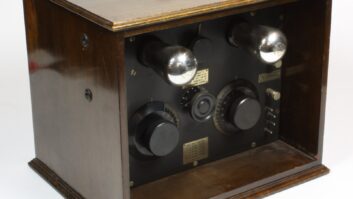Radio broadcasting and 700MHz
Feb 1, 2008 12:00 PM, By Kevin McNamara, CNE
The FCC is auctioning what may be the most important spectrum allocations of our time. This portion of spectrum will be available as a result of the FCC mandate for traditional analog broadcast television to migrate to the new digital HDTV system by Feb. 17, 2009, specifically the portion previously occupied by channels 60-69. As of this writing, the auction has raised more than $6 billion and is expected to approach $10 billion before it ends. One reason this spectrum is so valuable is that it will likely be the last new spectrum made available in the U.S. for land-based mobile telecom applications.
Coverage area
Unlike the power, height and adjacent-channel interference criteria used to determine the class of operation of a traditional broadcast station, wireless licenses are issued based on a specific geographic area. In the wireless world, there are several types of licenses issued that cover local, regional or national footprints. It is important to understand how the bids are formulated based on the level of coverage.

The revised 700MHz band plan for commercial use.
Click image to enlarge.
Cellular Market Area (CMA) � This represents the smallest geographic area in which a wireless license is issued. The CMA is comprised of two geographic areas: Metropolitan Statistical (MSA), including 306 local areas; and Rural Service (RSA), defining 428 local areas. In total, there are 734 CMAs throughout the U.S. and possessions.
Economic Area (EA) � Created by the Department of Commerce, this divides the U.S. and possessions into 172 areas that vary in size depending on certain economic criteria. Generally, the size of these areas decreases in proximity to larger cities.
Regional Economic Area Grouping (REAG) � Comprises the 172 EA and four additional geographic areas. These have been combined into 12 geographic areas covering the U.S. and will be bid as a package of 12 licenses if the reserves are met in the first round.
In addition, the 700MHz auction will also issue one nationwide license to a successful bidder.
Licenses to be auctioned
The current auction, Auction 73, will issue five blocks of licenses. Each block is labeled A through E and defines a specific range of operating frequencies, available bandwidth, frequency pairing and geographic area. As many as five licenses can be issued to any one area. I would expect all five blocks to be grabbed in at least the top 100 markets.
In addition to the commercial licenses, there is 24MHz of spectrum dedicated to the development of a national public safety network, 12MHz for narrowband operation and 12MHz of wideband operation.
The major bidders
The FCC has mandated that bids remain anonymous; however, we do know who was included because of the rigorous financial prescreening process. In the end, 214 companies were deemed qualified to bid in the first round. Among the notable telecom players, Verizon Wireless, AT&T Wireless, Cox and Cricket topped the list. Chevron Oil was also included.
The most interesting entrant into the auction is Google, who has committed to bid up to $4.6 billion for C block licenses. Google and other bidders lobbied the FCC to permit open access on the C block. The FCC agreed under the condition the C block fetches a minimum of $4.6 billion, otherwise the block will be re-bid without the ability for open access.
The 700MHz band provides better coverage and ability to penetrate buildings than the current 850 and 1900MHz spectrum used by mobile telephone/data networks and the (unlicensed) 2400 and 5800MHz spectrum used for wireless Ethernet. The lower frequency also permits a wider coverage area per site versus that required for a traditional (850/1900) cell site. To put this in perspective, one 700MHz site could cover the equivalent area now covered by four traditional cell sites.

Detail of the public safety revision.
Click image to enlarge.
In economic terms, the cost to deploy a 700MHz system over a traditional mobile telephone network nationally could save billions of dollars due to the need for fewer sites, lower cost to provision and lower maintenance/operation costs.
Expected technologies
These allocations permit bandwidth from 6 to 22MHz depending on the block awarded. Anything could be possible: voice, data, audio, video, data casting, remote monitoring, telemation, wholesale rental of spectrum, etc.; the possibilities are endless.
These bandwidths are sufficient to create a platform capable of supporting any of the current and emerging technologies. Other than some of the proposed proprietary schemes, GSM, UMTS and Wimax are natural fits for this application. I would expect it marketed as some form of advanced mobile data network. Much of the success for this service will hinge on having the proper network interface, typically a telephone handset, PC card or external router.
The impact to broadcasters
You need to watch this! The potential effect to traditional and satellite broadcasters can be significant since completely new platforms will be deployed, which are capable of delivering a higher level of voice, data, video and audio program delivery along with the ability to be fully interactive with the end-user. Apple is planning a version of the Iphone that will work for this service. Other manufacturers are expected to release handsets that give users the ability to provide telephone, data and full Internet access through the network. We are on the leading edge of finally having a single device that fulfills all our information and entertainment needs.
There are already providers offering various news and music formats nationally, but there might also be opportunity for savvy broadcasters to partner with these services providing local content, etc.
Remember, these services are not prohibited from seeking local or national advertising revenue; as a pay service they are also free of language/content restrictions. A potential owner such as Google already has a well-developed national sales team to support its Web operation; do you think it would be difficult for them to expand that sales effort to wireless?
Stay tuned.
McNamara is president of Applied Wireless, Cape Coral, FL.
For maps of each geographic area and more detailed information on spectrum allocations and auction results, visit the Auction 73 Web page at http://wireless.fcc.gov/auctions/default.htm?job=auction_factsheet&id=73.










